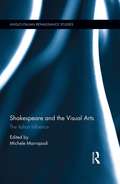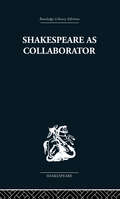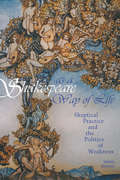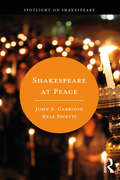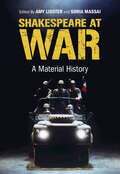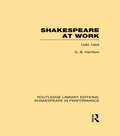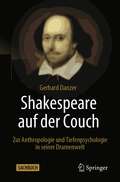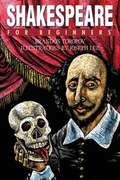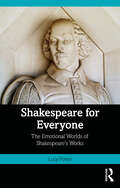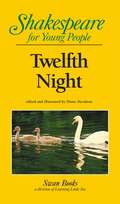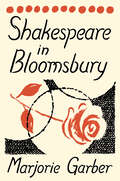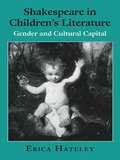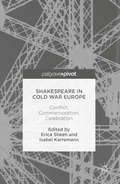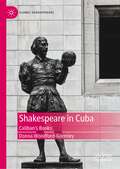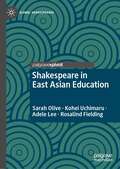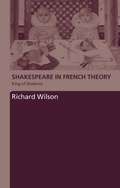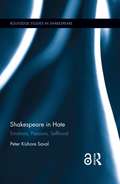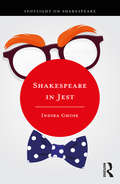- Table View
- List View
Shakespeare and the Visual Arts: The Italian Influence (Anglo-Italian Renaissance Studies)
by Michele MarrapodiCritical investigation into the rubric of 'Shakespeare and the visual arts' has generally focused on the influence exerted by the works of Shakespeare on a number of artists, painters, and sculptors in the course of the centuries. Drawing on the poetics of intertextuality and profiting from the more recent concepts of cultural mobility and permeability between cultures in the early modern period, this volume’s tripartite structure considers instead the relationship between Renaissance material arts, theatre, and emblems as an integrated and intermedial genre, explores the use and function of Italian visual culture in Shakespeare’s oeuvre, and questions the appropriation of the arts in the production of the drama of Shakespeare and his contemporaries. By studying the intermediality between theatre and the visual arts, the volume extols drama as a hybrid genre, combining the figurative power of imagery with the plasticity of the acting process, and explains the tri-dimensional quality of the dramatic discourse in the verbal-visual interaction, the stagecraft of the performance, and the natural legacy of the iconographical topoi of painting’s cognitive structures. This methodolical approach opens up a new perspective in the intermedial construction of Shakespearean and early modern drama, extending the concept of theatrical intertextuality to the field of pictorial arts and their social-cultural resonance. An afterword written by an expert in the field, a rich bibliography of primary and secondary literature, and a detailed Index round off the volume.
Shakespeare and the Visual Imagination
by Stuart SillarsShakespeare's knowledge of the practices of visual art, its fundamental concepts and the surrounding debates is clear from his earliest works. This book explores this relationship, showing how key works develop visual compositions as elements of dramatic movement, construction of ideas, and reflections on the artifice of theatre and language. The Taming of the Shrew, Love's Labour's Lost, Richard II and A Midsummer Night's Dream are explored in detail, offering new insights into their forms, themes, and place in European traditions. The use of emblems is examined in Titus Andronicus and As You Like It; studies of Venus and Adonis, some sonnets and The Rape of Lucrece reveal different but related visual aspects; a later chapter suggests how the new relation between seeing and soliloquy in The Rape of Lucrece is developed in other plays. Extensively illustrated, the book explores Shakespeare's assimilation and exploration of visual traditions in structure, theme and idea throughout the canon.
Shakespeare and: The Merry Wives of Windsor (ISSN)
by Elizabeth SchaferSeismic shifts in the theatrical meanings of The Merry Wives of Windsor have taken place across the centuries as Shakespeare’s frequently performed play has relocated to Windsor across the world, journeying along the production/adaptation/appropriation continuum.This (eco-)performance history of Shakespeare’s The Merry Wives of Windsor not only offers the first in-depth analysis of the play in production, with a particular focus on the representation of merry women, but also utilises the comedy’s forest-aware dramaturgy to explore Mistress Page’s concept of being ‘frugal in my mirth’ in relation to sustainable theatre practices. Herne’s Oak – the fictitious tree in Windsor Forest where everyone meets in the final scene of the play – is utilised to enable a maverick but ecologically based reframing of the productions of Merry Wives analysed here.This study engages with gender, physical comedy, and cultural relocations of Windsor across the world to offer new insight into Merry Wives and its theatricality.
Shakespeare as Collaborator
by Kenneth MuirThis edition first published in 1960. This book discusses the extent of Shakespeare's collaboration in the plays of Edward III, The Two Noble Kinsmen, Pericles and the lost Cardenio. It includes chapters on the dramatic value of the plays irrespective of authorship.
Shakespeare as Literary Dramatist
by Lukas ErneIn this groundbreaking study, Lukas Erne argues that Shakespeare, apart from being a playwright who wrote theatrical texts for the stage, was also a literary dramatist who produced reading texts for the page. The usual distinction that has been set up between Ben Jonson on the one hand, carefully preparing his manuscripts for publication, and Shakespeare the man of the theatre, writing for his actors and audience, indifferent to his plays as literature, is questioned in this book. Examining the evidence from early published playbooks, Erne argues that Shakespeare wrote many of his plays with a readership in mind and that these 'literary' texts would have been abridged for the stage because they were too long for performance. The variant early texts of Romeo and Juliet, Henry V, and Hamlet are shown to reveal important insights into the different media for which Shakespeare designed his plays.
Shakespeare as a Way of Life: Skeptical Practice and the Politics of Weakness
by James KuznerShakespeare as a Way of Life shows how reading Shakespeare helps us to live with epistemological weakness and even to practice this weakness, to make it a way of life. In a series of close readings, Kuzner shows how Hamlet, Lucrece, Othello, The Winter’s Tale, The Tempest, and Timon of Athens, impel us to grapple with basic uncertainties: how we can be free, whether the world is abundant, whether we have met the demands of love and social life.To Kuzner, Shakespeare’s skepticism doesn’t have the enabling potential of Keats’s heroic “negativity capability,” but neither is that skepticism the corrosive disease that necessarily issues in tragedy. While sensitive to both possibilities, Kuzner offers a way to keep negative capability negative while making skepticism livable. Rather than light the way to empowered, liberal subjectivity, Shakespeare’s works demand lasting disorientation, demand that we practice the impractical so as to reshape the frames by which we view and negotiate the world.The act of reading Shakespeare cannot yield the practical value that cognitive scientists and literary critics attribute to it. His work neither clarifies our sense of ourselves, of others, or of the world; nor heartens us about the human capacity for insight and invention; nor sharpens our ability to appreciate and adjudicate complex problems of ethics and politics. Shakespeare’s plays, rather, yield cognitive discomforts, and it is just these discomforts that make them worthwhile.
Shakespeare at Peace (Spotlight on Shakespeare)
by John S. Garrison Kyle PivettiIn the current climate of global military conflict and terrorism, Shakespeare at Peace offers new readings of Shakespeare’s plays, illuminating a discourse of peace previously shadowed by war and violence. Using contemporary examples such as speeches, popular music, and science fiction adaptations of the plays, Shakespeare at Peace reads Shakespeare’s work to illuminate current debates and rhetoric around conflict and peace. In this challenging and evocative book, Garrison and Pivetti re-frame Shakespeare as a proponent of peace, rather than war, and suggest new ways of exploring the vitality of Shakespeare’s work for politics today.
Shakespeare at War: A Material History
by Sonia Massai Amy LidsterPresenting engaging, thought-provoking stories across centuries of military activity, this book demonstrates just how extensively Shakespeare's cultural capital has been deployed at times of national conflict. Drawing upon scholarly expertise in Shakespeare and War Studies, first-hand experience from public military figures and insights from world-renowned theatre directors, this is the first material history of how Shakespeare has been used in wartime. Addressing home fronts and battle fronts, the collection's broad chronological coverage encompasses the Seven Years' War, the American War of Independence, the Napoleonic Wars, the Russian War, the First and Second World Wars, and the Iraq War. Each chapter reveals an archival object that tells us something about who 'recruited' Shakespeare, what they did with him, and to what effect. Richly illustrated throughout, the collection uniquely uncovers the agendas that Shakespeare has been enlisted to support (and critique) at times of great national crisis and loss.
Shakespeare at Work, 1592-1603 (Routledge Library Editions: Shakespeare in Performance)
by G.B. HarrisonShakespeare against the background of his times, his world of the theatre and his dramatic development through the last years of Elizabeth’s reign. Originally published in 1933 and republished in 1958, this great work is an imagining, in plain narrative, of the life of Shakespeare backed with evidence of the history of the stage. Whatever wider significances modern critics distill from Shakespeare’s plays, it remains an elementary fact that he wrote plays to interest and entertain his contemporaries and this book takes a look at the immediate interests of his audience and how his work responded to them.
Shakespeare at Work: 1592-1603
by G. B. HarrisonProvides discussion of the plays of Shakespeare written and performed during this period.
Shakespeare auf der Couch: Zur Anthropologie und Tiefenpsychologie in seiner Dramenwelt
by Gerhard DanzerShakespeare ist als Autor weltberühmt. Er war allerdings nicht nur ein genialer Theater-Mann, sondern mindestens ein ebenso exzellenter Psychologe und Anthropologe, der das menschliche Dasein in allen seinen Schattierungen intuitiv verstanden, sowie mit künstlerischer Verve und literarischer Generosität auf die Bühne gebracht hat. Dieses Buch führt durch eine Auswahl seiner Stücke, fasst Handlungen zusammen, kommentiert Verhaltensweisen und interpretiert diese feinsinnig. Shakespeare wird hier als Psychologe und Anthropologe vorgestellt - höchst vergnüglich, hellsichtig und tiefgründig.
Shakespeare behind Bars: One Teacher's Story of the Power of Drama in a Women's Prison
by Jean TrounstineIn this deeply stirring account, Jean Trounstine, who spent 10 years teaching at Framingham (MA) Women's Prison, focuses on six inmates who, each in her own way, discover in the power of Shakespeare a way to transcend the painful constraints of incarceration. Shakespeare Behind Bars is a powerful story about the redemptive power of art and education. Originally published in cloth in 2001, the paperback includes a new foreword that will inspire all teachers who work with students others have deemed unteachable. A new afterword updates readers on the prison art's program -- and the author herself -- since 2001.
Shakespeare for Beginners
by Brandon ToropovWilliam Shakespeare stands as the greatest writer the English language has ever produced. Even so, many people have never read him. Covering all of Shakespeare's plays, this volume offers clear, concise descriptions and plot summaries of each work; it lists key phrases and important themes, explains the main ideas behind each play and features excerpts of important passages.
Shakespeare for Everyone: The Emotional Worlds of Shakespeare’s Works
by Lucy PotterShakespeare for Everyone offers an accessible and engaging introduction to the worlds of Shakespeare’s plays and sonnets.By focusing on emotions, it enables readers to build the skills and confidence to understand, appreciate, and enjoy Shakespeare’s plays by getting up close and personal with the characters in them, with their emotional journeys, and with the dramatic genres—of comedy, tragedy, tragicomedy, and history—in which they are cast. It provides insights into the forces that shaped Shakespeare’s work, and includes in-depth chapters on emotions in four representative plays: love in A Midsummer Night’s Dream, hate in Othello, jealousy in The Winter’s Tale, and the manipulation of emotions in Henry V. The book also considers how emotions were conceptualised in Shakespeare’s time and are understood today by modern psychological science. Additionally, the book enables readers to get to know Shakespeare himself, and gain insights into the processes of his art.Featuring end-of-chapter further reading sections and an invaluable glossary of key terms through which to unlock the meaning of any Shakespeare play, this practical and informative guide proves that Shakespeare is for everyone. Written in a conversational tone, this short yet compelling book is not just a series of insights into what Shakespeare’s plays mean, but a way of exploring what it is to be human.
Shakespeare for Freedom
by Ewan FernieShakespeare for Freedom presents a powerful, plausible and political argument for Shakespeare's meaning and value. It ranges across the breadth of the Shakespeare phenomenon, offering a new interpretation not just of the characters and plays, but also of the part they have played in theatre, criticism, civic culture and politics. Its story includes a glimpse of 'Freetown' in Romeo and Juliet, which comes to life in the 1769 Stratford Jubilee; the Shakespearean careers of the Leicester Chartist, Cooper, and the Hungarian hero, Kossuth; Hegel's recognition of Shakespearean freedom as the modern breakthrough; its fatal effects in America; the disgust it inspired in Tolstoy; its rehabilitation by Ted Hughes, and its obscure centrality in the 2012 Olympics. Ultimately, it issues a positive Shakespearean prognosis for freedom as a vital (in both senses), unending struggle.
Shakespeare for Young People: Twelfth Night
by William Shakespeare Diane DavidsonShakespeare for Young People enables students to enjoy the great plays of Shakespeare in the original language. The scripts, which have been cut to be performed in forty minutes, include descriptions and stage actions as well as production notes to help novice directors and actors. While the texts include only Shakespeare's original words, announcers introduce the story and poetry in the plays by reading them aloud or by acting them out.
Shakespeare für Dummies (Für Dummies)
by Ray Lischner John DoyleEntdecken Sie die Geheimnisse von Romeo, Hamlet, Macbeth & Co. Dachten Sie bisher immer, dass Shakespeare eine Nummer zu groß für Sie ist? Oder gehören Sie zu denjenigen, die dank der zahlreichen Verfilmungen seiner Werke gerne mehr über ihn erfahren möchten? Oder möchten Sie einmal einen Blick in die englischen Originale werfen? Dann sollten Sie sich dieses Buch nicht entgehen lassen. Fernab von trockenen Schulvorträgen und schlechten Aufführungen entführen Sie John Doyle und Ray Lischner in die spannende Welt von Shakespeare. Sie führen Sie an seine wichtigsten Werke heran: die Tragödien, Komödien, Historien und Sonette. Außerdem erfahren Sie alles über sein Leben und sein außergewöhnliches Englisch.
Shakespeare in Bloomsbury
by Marjorie GarberThe untold story of Shakespeare&’s profound influence on Virginia Woolf and the rest of the Bloomsbury Group &“A spirited dance of minds.&”—Chris Vognar, Boston Globe For the men and women of the Bloomsbury Group, Shakespeare was a constant presence and a creative benchmark. Not only the works they intended for publication—the novels, biographies, economic and political writings, stage designs and reviews—but also their diaries and correspondence, their gossip and small talk turned regularly on Shakespeare. They read his plays for pleasure in the evenings, and on sunny summer afternoons in the country. They went to the theater, discussed performances, and speculated about Shakespeare&’s mind. As poet, as dramatist, as model and icon, as elusive &“life,&” Shakespeare haunted their imaginations and made his way, through phrase, allusion, and oblique reference, into their own lives and art. This is a book about Shakespeare in Bloomsbury—about the role Shakespeare played in the lives of a charismatic and influential cast, including Virginia and Leonard Woolf, Vanessa Bell, Clive Bell, Roger Fry, Duncan Grant, Lytton Strachey, John Maynard Keynes and Lydia Lopokova Keynes, Desmond and Molly MacCarthy, and James and Alix Strachey. All are brought to sparkling life in Marjorie Garber&’s intimate account of how Shakespeare provided them with a common language, a set of reference points, and a model for what they did not hesitate to call genius. Among these brilliant friends, Garber shows, Shakespeare was in effect another, if less fully acknowledged, member of the Bloomsbury Group.
Shakespeare in Children's Literature: Gender and Cultural Capital (Children's Literature and Culture)
by Erica HateleyShakespeare in Children’s Literature looks at the genre of Shakespeare-for-children, considering both adaptations of his plays and children’s novels in which he appears as a character. Drawing on feminist theory and sociology, Hateley demonstrates how Shakespeare for children utilizes the ongoing cultural capital of "Shakespeare," and the pedagogical aspects of children’s literature, to perpetuate anachronistic forms of identity and authority.
Shakespeare in Cold War Europe
by Erica Sheen Isabel KarremannThis essay collection examines the Shakespearian culture of Cold War Europe - Germany, France, UK, USSR, Poland, Spain and Hungary - from 1947/8 to the end of the 1970s. Written by international Shakespearians who are also scholars of the Cold War, the essays assembled here consider representative events, productions and performances as cultural politics, international diplomacy and sites of memory, and show how they inform our understanding of the political, economic, even military, dynamics of the post-war global order. The volume explores the political and cultural function of Shakespearian celebration and commemoration, but it also acknowledges the conflicts they generated across the European Cold War 'theatre', examining the impact of Cold War politics on Shakespearian performance, criticism and scholarship. Drawing on archival material, and presenting its sources both in their original language and in translation, it offers historically and theoretically nuanced accounts of Shakespeare's international significance in the divided world of Cold War Europe, and its legacy today.
Shakespeare in Cuba: Caliban’s Books (Global Shakespeares)
by Donna Woodford-GormleyShakespeare in Cuba: Caliban’s Books explores how Shakespeare is consumed and appropriated in Cuba. It contributes to the underrepresented field of Latin American Shakespeares by applying the lens of cultural anthropophagy, a theory with Latin American roots, to explore how Cuban artists ingest and transform Shakespeare’s plays. By consuming these works and incorporating them into Cuban culture and literature, Cuban writers make the plays their own while also nourishing the source texts and giving Shakespeare a new afterlife.
Shakespeare in East Asian Education (Global Shakespeares)
by Adele Lee Rosalind Fielding Sarah Olive Kohei UchimaruThis book offers fresh, critical insights into Shakespeare in Hong Kong, Japan, and Taiwan. It recognises that Shakespeare in East Asian education is not confined to the classroom or lecture hall but occurs on diverse stages. It covers multiple aspects of education: policy, pedagogy, practice, and performance. Beyond researchers in these areas, this book is for those teaching and learning Shakespeare in the region, those teaching and learning English as an Additional Language anywhere in the world, and those making educational policies, resources, or theatre productions with young people in East Asia.
Shakespeare in French Theory: King of Shadows
by Richard WilsonAt a time when the relevance of literary theory itself is frequently being questioned, Richard Wilson makes a compelling case for French Theory in Shakespeare Studies. Written in two parts, the first half looks at how French theorists such as Bourdieu, Cixous, Deleuze, Derrida and Foucault were themselves shaped by reading Shakespeare; while the second part applies their theories to the plays, highlighting the importance of both for current debates about borders, terrorism, toleration and a multi-cultural Europe. Contrasting French and Anglo-Saxon attitudes, Wilson shows how in France, Shakespeare has been seen not as a man for the monarchy, but a man of the mob. French Theory thus helps us understand why Shakepeare’s plays swing between violence and hope. Highlighting the recent religious turn in theory, Wilson encourages a reading of plays like Hamlet, Julius Caesar, A Midsummer Night’s Dream and Twelth Night as models for a future peace. Examining both the violent history and promising future of the plays, Shakespeare in French Theory is a timely reminder of the relevance of Shakespeare and the lasting value of French thinking for the democracy to come.
Shakespeare in Hate: Emotions, Passions, Selfhood (Routledge Studies in Shakespeare)
by Peter Kishore SavalHate, malice, rage, and enmity: what would Shakespeare’s plays be without these demonic, unruly passions? This book studies how the tirades and unrestrained villainy of Shakespeare’s art explode the decorum and safety of our sanitized lives and challenge the limits of our selfhood. Everyone knows Shakespeare to be the exemplary poet of love, but how many celebrate his clarifying expressions of hatred? How many of us do not at some time feel that we have come away from his plays transformed by hate and washed clean by savage indignation? Saval fills the great gap in the interpretation of Shakespeare’s unsocial feelings. The book asserts that emotions, as Aristotle claims in the Rhetoric, are connected to judgments. Under such a view, hatred and rage in Shakespeare cease to be a "blinding" of judgment or a loss of reason, but become claims upon the world that can be evaluated and interpreted. The literary criticism of anger and hate provides an alternative vision of the experience of Shakespeare’s theater as an intensification of human experience that takes us far beyond criticism’s traditional contexts of character, culture, and ethics. The volume, which is alive to the judgmental character of emotions, transforms the way we see the rancorous passions and the disorderly and disobedient demands of anger and hatred. Above all, it reminds us why Shakespeare is the exemplary creator of that rare yet pleasurable thing: a good hater.
Shakespeare in Jest (Spotlight on Shakespeare)
by Indira GhoseShakespeare in Jest draws fascinating parallels between Shakespeare's humour and contemporary humour. Indira Ghose argues that while many of Shakespeare's jokes no longer work for us, his humour was crucial in shaping comedy in today's entertainment industry. The book looks at a wide variety of plays and reads them in conjunction with examples from contemporary culture, from stand-up comedy to late night shows. Ghose shows the importance of jokes, the functions of which are remarkably similar in Shakespeare’s time and ours. Shakespeare's wittiest characters are mostly women, who use wit to puncture male pretensions and to acquire cultural capital. Clowns and wise fools use humour to mock their betters, while black humour trains the spotlight on the audience, exposing our collusion in the world it skewers. In a discussion of the ethics of humour, the book uncovers striking affinities between Puritan attacks on the theatre and contemporary attacks on comedy. An enjoyable and accessible read, this lively book will enlighten and entertain students, researchers, and general readers interested in Shakespeare, humour, and popular culture.
